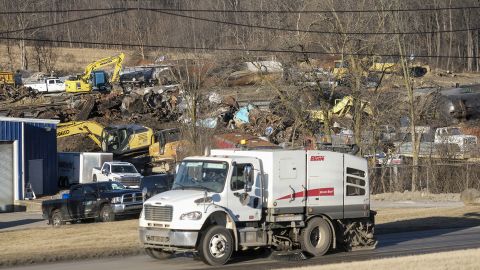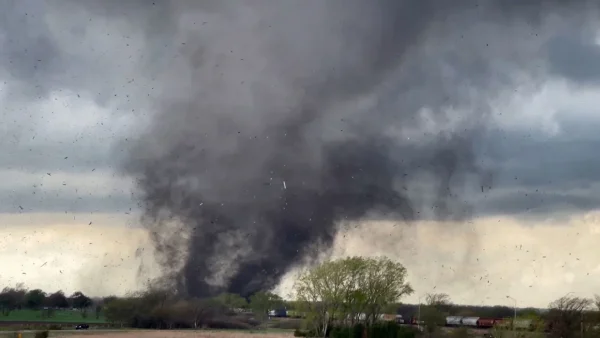As crews remove contaminated soil and liquid from Ohio toxic train wreck site, concerns emerge about where it’s going
February 27, 2023
CNN– After a brief pause, shipments of contaminated liquid and soil from the toxic train derailment in East Palestine, Ohio, will resume Monday amid concerns – including from other states – about the movement of the hazardous waste.
The Environmental Protection Agency over the weekend approved resuming shipments of the contaminated waste to two EPA-certified sites in Ohio: Heritage Thermal Services in East Liverpool and Vickery Environmental in Vickery.
The move came after the agency on Friday ordered the train’s operator, Norfolk Southern, to halt the shipments so that it could review the company’s plans for disposal as officials in Texas and Michigan complained they didn’t receive any warning that waste from the crash would be shipped into their jurisdictions for disposal.
The hazardous waste material already sent to Michigan and Texas is now being processed, EPA regional administrator Debra Shore said at a news conference Sunday.
Questions about the disposal of toxic waste from the February 3 derailment have added to the controversy surrounding the crash that has also left residents of the town worried about potential long-term health effects.
The mayor of East Liverpool, one of the towns set to incinerate the waste, expressed concerns about the process but said the EPA has assured him that everyone has been following necessary guidelines.
“We have a 2-year-old daughter and of course that’s a concern,” Mayor Gregory T. Bricker said. “But, again, I think this is a state-of-the-art facility that can handle this type of waste.”
So far, about 1.8 million gallons of liquid waste and 4,832 cubic yards of solid waste have been pulled from the derailment site, according to the office of Ohio Gov. Mike DeWine.
About 2 million gallons of firefighting water from the train derailment site were expected to be disposed in Harris County, Texas, with about half a million gallons already there, the county’s chief executive said last week. Meanwhile, contaminated soil from the derailment site was taken to the US Ecology Wayne Disposal in Belleville, Michigan, according to US Rep. Debbie Dingell of Michigan.
Until Friday, Norfolk Southern had been “solely responsible” for disposing of waste from the train derailment, but waste disposal plans “will be subject to federal EPA review and approval moving forward,” Shore said.
Every aspect of transporting and disposing of the hazardous waste material “from the moment trucks and rail cars are loaded until the waste is safely disposed of” will be closely regulated and overseen by federal, state, and local governments, Shore said at a Sunday news conference.
After speaking to residents in East Palestine, Shore said it’s clear “that everyone wants this contamination gone from the community” and “we owe it to the people of East Palestine to move it out of the community as quickly as possible.”
“At the same time, I know there are folks in other states who have concerns, legitimate concerns, about how this waste is being transported and how it will be disposed of. EPA will continue to work with our local, state, and federal partners to use our longstanding experience and expertise in these matters to ensure the health and safety, and support the East Palestine community and to hold Norfolk Southern accountable,” Shore added.
New wells will measure contamination in the groundwater below

The fiery derailment and subsequent intentional release of vinyl chloride from its cars left East Palestine residents with anxiety about the safety of their air and water as reports of symptoms like rashes and headaches emerged.
So far, tests of East Palestine’s public drinking have found “no indication of risk to East Palestine public water system customers” and “treated drinking water shows no detection of contaminants associated with the derailment,” the EPA said in its Sunday update.
Also, testing of the air inside 578 East Palestine homes has detected no contaminants linked to the derailment, according to the agency.
But as anxiety remains, federal teams are going door-to-door in East Palestine to check in with residents, conduct health surveys and provide informational flyers after President Joe Biden directed the move, a White House official told CNN.
And this week, new wells will be drilled “to determine if ground water immediately below the derailment site is contaminated,” DeWine’s office announced Sunday.
Four wells have been installed and up to three more will be drilled this week after the soil under the rails is completely excavated, officials said. Fourteen wells in total are planned.
“These monitoring wells will also support a better understanding of the direction and rate of the ground water flow in the area,” DeWine’s office said.
Officials say crews have made good progress clearing the charred remains of the train from crash site in East Palestine.
All rail cars, except for 11 held by investigators, have been removed from the site of the derailment, Ohio Environmental Protection Agency Director Anne Vogel said in an update Sunday.
“This is so critically important to moving on to next steps. We can now excavate additional contaminated soil and began installing monitoring wells,” Vogel said. The Ohio EPA will oversee the installation of water monitoring wells at the site of the derailment that will measure contaminant levels in the groundwater below.
Derailment was ’100% preventable’: NTSB official says
As cleanup of the site continues, investigators are already probing the causes of the crash.
So far, the investigation found the crew did not do anything wrong prior to the derailment, though the crash was “100% preventable,” Jennifer Homendy, the chair of the safety board, said last week.
A National Transportation Safety Board preliminary report found that one of the train’s cars carrying plastic pellets was heated by a hot axle that sparked the initial fire, Homendy said. Video of the train before the crash showed what appeared to be an overheated wheel bearing, the report said.
What caused the wheel bearing failure will be key to the investigation, Homendy added.
The investigation will also look into the train’s wheelset and bearing, the designs of tank cars and railcars, the maintenance procedures and practices, as well as the damage from the derailment, the NTSB report noted.
















